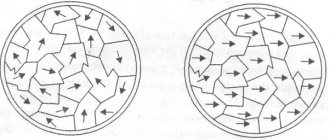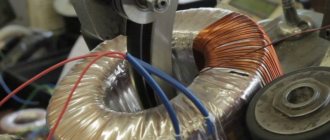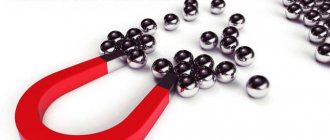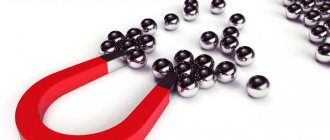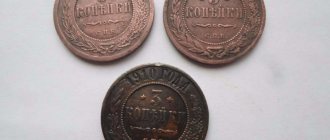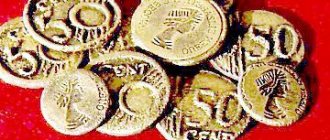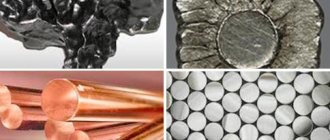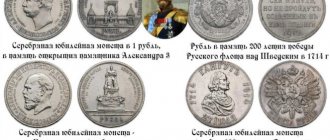Main differences
Whether a coin is attracted to a magnet depends on what it is made of. Magnetic coins are minted from a clad steel alloy. Those that are not magnetic most often have brass or copper as their base. As a rule, magnetic coins are more expensive, although it all depends on the specific specimen.
There are signs that, besides the magnet, help distinguish between the two types. During use, the magnetic coin has a smooth edge and wears off over time and begins to look like graphite. The edge of a non-magnetic coin is flat and often decorated with corrugation. A coin made of clad steel has a rounded transition from the edge to the edge, unlike a coin made of brass, where this transition occurs at a right angle.
Any numismatist should know how to distinguish such coins. If this causes difficulty, of course, you can use a regular magnet. For most coins there is no significant difference in cost, but there are certain specimens for which this parameter plays a primary role.
20 rubles produced in 1993
The determining factor in this case is the rarity of the coin itself. The most expensive specimens, differing from similar ones in magnetic characteristics, are:
- A coin with a face value of 10 rubles, minted in 1992. This year’s magnetic coin has a very high cost, about 25 thousand rubles, while the non-magnetic coin is worth nothing.
- In 1993, a 10-ruble coin was again issued, the magnetic properties of which affect its value. It was minted at both the Moscow and Leningrad mints and, accordingly, may have the mark MMD or LMD. In this case, a non-magnetic coin has a high price, but a magnetic one is very common and can be bought for a nominal price.
- In 1993, a 20-ruble coin was also minted, which was also made at both mints and is valuable only in a magnetic copy.
- In 2007, a mistake was made, thanks to which the coins of 10 and 50 kopecks of this year of issue became very valuable, but it was the non-magnetic copies.
Magnetic and non-magnetic coins of 1992-1993
When it comes to magnetic and non-magnetic coins, you will need any magnet and further instructions. First of all, it must be said that this issue concerns only two denominations: 10 and 20 rubles. You don’t have to pay attention to coins of other denominations. The background is as follows: in 1992, blanks from a copper-nickel alloy were used for minting. In 1993, the expensive alloy was replaced with a cheaper option, the base of the workpiece was steel, and the copper-nickel alloy was applied on top in a thin layer. Accordingly, 1992 coins are not magnetic (do not stick to a magnet), but 1993 coins are magnetic (stick to a magnet). But at some point at the mint the blanks were mixed up, and the 1993 coins were struck on the 1992 blanks and vice versa. All of them are described in detail in numismatic literature, so to determine rarities you just need to take a magnet and apply it to the coin.
Here is a list of rarities:
or, in a nutshell: valuable 1992 is magnetic, valuable 1993 is not magnetic, if on the contrary - the coins are ordinary.
How to distinguish a mint mark:
Coins of the Russian Empire
At that time, coins were made of copper, and as you know, copper is not magnetic. However, not so long ago copper coins were found that still have magnetic properties. Most likely, such copper simply contains a huge amount of impurities. About forty such coins have been discovered in Russia and Ukraine, and their number continues to grow. The prices, of course, are also quite high. Such coins have some regularities:
- their authenticity is 100% established;
- almost all were made in Yekaterinburg, with the exception of two;
- the year of minting of coins varies, from 1753 to 1844;
- most of it is black;
- different specimens are attracted to the magnet in different ways;
- only some of them have been found in collections.
All copper coins that have magnetic properties have a number of distinctive features. They may have porosity, inclusions, and their weight varies. Particularly valuable is the single-sided 2-kopeck coin, minted with a proof die for minting in Warsaw in 1848. It does not have an imprint on the reverse; its value is determined by auction.
Magnetic coins of the Russian Empire
Royal Magnetic Coin
The minting of change coins at that time, according to the decrees, was carried out from copper, but studies have shown that they can be distinguished by the force of attraction to a magnet. It was in 2003 that previously unknown copper coins were found in Russia that had magnetic properties.
At the moment, about forty such coins have been discovered in Russia and Ukraine. But they continue to be found in various parts of the country, and the price of such specimens is rising. This allows us to identify some patterns:
- the undoubted authenticity of these coins has been established, there are no exceptions;
- all of them, except two, were minted in Yekaterinburg;
- these coins range in date from 1753 to 1844;
- most of them are black;
- different specimens demonstrate different strengths of attraction to the magnet;
- Almost all of the above coins were found in collectors' exchange funds or from sellers; they are not in circulation. It’s just that no one had previously thought to test them for unusual properties;
- only a small part of them was discovered in the collections of Russian collectors.
All copper magnetic coins have a number of interesting features. The differences between coins and their mediocre quality usually depend on the quality of the copper, the presence of inclusions and porosity. They can be distinguished by weight - the weight of 2 kopecks is almost equal to the weight of a ruble coin, and the weight of a kopeck is equal to half a coin.
There is a rare single-sided 2 kopeck coin from 1848, a proof stamp for Warsaw minting, the price of which is determined only through auction. There is no print on the front side.
Coins in the USSR
Some of the specimens from this time react to the magnet. No research has yet been conducted, but magnetic coins have been found in a variety of years and denominations. Recently, numismatists are often faced with the need to check their coins for magnetization. As the experience of people who have tested a sufficient number of coins shows, silver-colored coins do not have magnetic properties at all. The 3 and 5 kopeck coins made of copper showed mixed results.
Most of the specimens turned out to be non-magnetic, but some especially rare ones still showed magnetic properties. Coins that are apparently made using ferromagnets are 5 kopecks from 1991 and 3 kopecks from 61.62, 82, 90 and 91. It is assumed that during the manufacture of the blanks, iron somehow got into the alloy.
10 rubles issued in 1992
Magnetic coins of the USSR
USSR magnetic coin
Some of the examples from the Soviet Union interact with a magnet, although they should not contain metals capable of this. So far, a complete study has not been carried out, but magnetic coins of different denominations have been discovered.
Numismatists in Russia began to independently check their collections for the presence of magnetic attraction, because the price of a coin can be high. Silver-colored coins, according to experimenters, are not magnetic at all; they do not contain the necessary components. But copper coins, in denominations of 3 and 5 kopecks, showed less clear results.
Most of the coins tested were non-magnetic, but some showed weak or even strong attraction.
A weak reaction to the magnet was shown by 3 kopecks issued in 1970, 1982, 1986, 1988, 1990 and 1991, as well as 5 kopecks issued in 1990 and 1991. And strong attraction was demonstrated by 3 kopecks from 1961, 1962, 1982, 1990 and 1991, and of the 5 kopecks only coins issued in 1991 responded. Numismatists themselves explain this phenomenon by violations of the recipe, as a result of which iron got into the composition. This does not cause the price of the coin to fall.
Coins after 1991
Changes in the structure of the state led to the destruction of a huge number of coin issues. The cost of such copies has become noticeably higher. Materials also skyrocketed in price, so in 1993 steel began to be used instead of an alloy of nickel and copper. As a result, the bulk of the coins are magnetic, but remnants of alloys from previous years were also used. And in order to ensure that the coins did not differ in appearance, all steel coins were coated with a nickel-copper alloy by sputtering. This is where the rare 10-ruble coin of these years appeared.
As with coins with other rare properties, their difference from the main lot is most often the result of an error. But such an error can, as can be seen, lead to significant changes in value. Therefore, it is important to carefully review your collection; perhaps it contains a rare exhibit. It is also worth checking other coins for the presence of magnetic properties, in case enthusiasts missed something.
Previously, buying an old silver coin from Tsarist Russia was not so easy. Now it's harder not to buy it. Lively merchants are constantly on guard for careless citizens near shopping centers or hypermarkets. But the product they offer has nothing to do with antiquity. And many potential collectors, having been burned, prefer not to get involved with the pre-revolutionary period at all. We offer you some simple tips on how to distinguish copies or fakes from genuine coins, which are worth good money.
Minting materials
For minting, aluminum bronze, cupronickel, copper, brass and other alloys are used. What are these, magnetic and non-magnetic coins? The latter are not attracted by a magnet. But only numismatists are able to give an appropriate assessment of this or that monetary unit, determine its parameters and value.
Non-magnetic coins
Why are coins of the same denomination (magnetic, non-magnetic) minted in the same year, but have different prices? Numismatists know how to distinguish a magnetic coin from a non-magnetic one. The main thing is that they differ in the alloy from which they are made. In addition, they have other features:
| Non-magnetic | Magnetic |
| For manufacturing, manufacturers use brass and copper in the alloy. | The alloy includes clad steel, it has hardness, wear resistance, resistance to corrosion, exposure to aggressive environments and saves expensive materials. |
| The edge is flat. Often decorated with corrugation. | When using the coin, the smooth edge wears off and has a graphite color (dark gray). |
| The edging with the edge forms a right angle. | The edging has a rounded appearance. |
| Not attracted to a magnet. | Magnetic. |
Exclusive money differs from its analogues in its magnetic properties.
- Value is determined by uniqueness and rarity. For example, a magnetic banknote with a face value of 10 rubles, minted in 1992 at the MMD (Moscow Mint), is practically not found or is found very rarely, therefore it is highly valued and the cost is growing every year. On average, a coin is valued at 25 thousand rubles. And non-magnetic ones of the same denomination are found very often. They are produced in large quantities, so the cost is low.
- If we consider the year of issue 1993, then a small number of 10-ruble non-magnetic banknotes were minted, and therefore their cost is correspondingly high. The ten-ruble note was produced at MMD and LMD (Leningrad Mint). It has the corresponding manufacturer's mark. On the contrary, they produced a lot of magnetic ones, so they are inexpensive, their price is almost equal to the nominal rating.
- The mints minted the 20-ruble coin in 1993. Only the magnetic version of this banknote is valuable. It should be noted that when releasing non-magnetic 10 and 50 kopeck coins in 2007, the manufacturers made a mistake - they gave the denominations a high rating.
Non-existent coins
Understand the period whose coins you want to purchase. It’s problematic to buy something profitable on a topic that you don’t understand. And an apparent profit can turn into a global loss. The easiest way is to know at least in general terms what genuine coins look like. And what they might not look like.
The illustration shows a coin that cannot have an original. After all, the first gold tens with a portrait of Nicholas II appeared only in 1898. Knowing the circulation of a particular coin can be of great help. If only a few dozen of these coins were minted, the likelihood that the treasured original is in the hands of a life-worn peasant who wants to foist it on you tends to zero.
Tooth and ear
Let's remember the scenes from Westerns when a silver dollar was checked for a tooth by biting and examining the bite site. Of course, no one will allow you to bite a collectible coin. And if the seller gives it to you from dirty hands, the very desire to use this method will disappear. But hearing can help us. In restaurants, the head waiter checks the wine glasses by lightly striking their rim and separating the crystal from the glass using a characteristic ringing sound. Coins made of precious metals also have a characteristic ringing sound. Try carefully dropping a silver coin onto a hard surface and you will hear a clear and melodious ringing sound. But this method is not suitable for coins that have been on fire.
Steel base
The steel “core” is clearly visible if the coin is cleaned by removing the coating. For bare coins, the spectrometer shows a higher iron content, close to 80-90%.
“To reduce the cost of coins, a steel base is definitely good. But for corrosion resistance, it’s not good,” says chemist Evgeniy Okaev. — An iron-based alloy produces a galvanic couple with brass or copper and corrodes faster than in the absence of such contact. However, this can only appear when the outer brass or copper coating is completely worn off in at least one place, and this will not happen soon.”
By the way, it is precisely because of the steel “filling” that our coins are easily magnetic.
Ukrainian and Russian coins, as well as small euro cents, have a steel base. Soviet money did not have a steel base - coins were made from an alloy of copper with zinc and nickel. It is not available in dollars or zlotys.
Magnetic properties
A magnet is an indispensable assistant in cases where suspicious silver is offered. As is known, silver does not have magnetic properties. Therefore, if a silver ruble with a portrait of Peter the Great or Alexander the Second suddenly begins to be perfectly magnetic, this circle with magnetic properties, reminiscent of a coin, cannot cost more than a hundred rubles.
An equally obvious miscalculation by counterfeiters will be observed on a gold-plated coin made of a magnetic alloy, because real gold, as is known, does not have magnetic properties either.
Foreign metal
A magnet will not save you if, under the guise of royal silver, you are offered to buy coins made of a non-magnetic alloy. Carefully examine the candidate for purchase. Very often, a fake is easily identified by abrasions, in which the color differs sharply from the original metal.
Above is the “Wedding Ruble”. In the original it is a very valuable coin. But this is a cheap fake, made of brass and coated with a layer that imitates silver. However, yellow “bald patches” can easily debunk the rarity in the eyes of even a novice numismatist.
The main coating material is copper
There is copper in the coating of every Belarusian coin, and in all coins except 1 ruble, copper is the basis of the alloy. There are practically no other components in the shell of 1, 2 and 5 kopecks.
“Copper is the most commonly used and proven metal in coinage,” explains Evgeniy Borisovich.
True, a copper coin can change color over time.
“Coins containing copper darken either from oxidation or, for example, from contact with hydrogen sulfide or other sulfur-containing substances,” explains the specialist. “Perhaps the second coin (pictured on the right - TUT.BY note ) was stored in just such conditions, for example, close to household waste and their decomposition products.”
The Belarusian "trifle" in its composition is most similar to 1, 2 and 5 euro cents - they are also made of steel and coated with copper without impurities. Copper is the basis of the shell of coins in the USA, Korea, Poland and the Eurozone; it was this metal that was the main component of Soviet kopecks. In Russia and Ukraine, some coins are coated primarily with copper, while others are coated with nickel.
Character of the metal
If you pass a sufficient number of genuine coins through your hands, the eye gets used to it and fixes in memory a certain standard, with which suspicious specimens will then be compared. Experience will easily turn on an alarm when a coin is unnaturally shiny or, on the contrary, has an excessive dullness of the coin field.
Above is a crude fake of the gold five-ruble note of Nicholas II. If a collector has already purchased or seen enough similar coins, then even the image of the emperor will scare him away. A beginner should be wary of the strange surface of the coin. This is not gold coinage, this coating is unknown with what, moreover, it is handicraft. The smooth coin field is completely absent.
Edge like litmus test
While manufacturers of fakes, copies and replicas pay sufficient attention to the obverse and reverse of counterfeits, the edge is very often far from the original. Therefore, do not be surprised when you post photographs of both sides of the coin to determine the authenticity, they will immediately irritably remark to you, “Where is the edge?!!!” The edge is the first thing experienced collectors look at, and if it meets the standard, then they study the obverse and reverse in detail. On copies imitating royal silver, there is almost always a depressed edge, as on coins of the last years of the Russian Empire, or a grooved edge. However, the herds were not always like this. So, for example, on the coins of Anna Ioanovna, the smooth edge is characteristic exclusively of gold coins. On silver rubles, the edge is made in the form of a leafy pattern, on the edge of the half coins we will see rhombuses in the form of a grid, and the half-poltinas and ten-kopeck pieces will show us a corded edge with a slope to the right. A difference from a genuine edge (for example, corrugations instead of leaves) immediately indicates a fake. An exception for some coins may be new coins. But they are never sold in hypermarket parking lots.
For an example of a characteristic edge, let’s take a genuine Elizabethan ruble from 1752 (photos on the left) and its copy (photos on the right). The original edge is a raised inscription (top photo). When making a copy, it is expensive to make such an edge, so unknown craftsmen, in order not to leave the third side of the coin suspiciously smooth, filled it with a pressed version from a much later time. The differences are striking! Although there is another secret here that allows an expert of that era to identify a fake without even looking at the edge. Under the eagle’s paws on the “copy” we see the letters “I” and “M”, which were minted only at the St. Petersburg Mint. That is, under the portrait of the empress there should be “SPB”, while we see a clear “MMD”. The stamp for the copy was made from the obverse and reverse of two different coins.
The unusual herd will make us immediately wary at the sight of this “Nicholas golden chervonets”. Anyone who has seen a genuine coin will notice the dissimilarity of the font (the edge of the original is shown above). But here too we can turn on the alarm by looking at the reverse of the dubious specimen. The manufacturer of the counterfeit not only failed to maintain the font of the date numbers, but was also simply too lazy to put a period after the letter “G”.
Carefully! Casting!
Making a fake stamp is not an easy task, although modern technologies can handle it quite well. But still, counterfeit manufacturers often choose a simpler method. This is cast from the mold used for the original coin. It would seem that the copy should be indistinguishable. Below you can see a coin made by casting.
But upon closer examination, especially using high magnification, the shortcomings of the technology immediately come to light. The surface of such a coin has a grainy structure. It is easy to find the remains of miniature bubbles resulting from the casting of the copy. In addition, the clarity of the letters and details of the design, amazing when embossed, becomes smoothed out when poured. The outlines will be softened and blurry. And the place where the letters transition into the coin fields, instead of a clear right angle, forms a rolling hill.
Mass and geometry
And, of course, we should not forget about the technical characteristics inherent in the coin. First of all, you should check the weight. Due to the substitution of metal, the weight of the fake is very different from the original, and the scale will immediately demonstrate this.
To adjust the weight, counterfeiters often change the thickness, which is also worth paying close attention to. And finally, the diameter. Deviations from the original, greater or lesser, should be alarming. If a coin is made of gold or silver, its specific gravity must match the specific gravity of the metal used to make it (taking into account the fineness).
Until recently, producing counterfeits was labor-intensive and manual labor. As an example, here is an interesting similarity to a “Do it yourself” kit, where the future counterfeiter will have to fill in the middle of the “product”. But modern technologies, unfortunately, are increasingly improving the work of copy makers, constantly improving the quality of fakes. And numismatists are anxiously awaiting whether the day will come when it will become impossible to find differences. But that day has not come yet. For now, fakes are easily distinguishable by collectors who have studied their favorite topic. And counterfeiters are sometimes let down by curious details. Therefore, we will end our mini-directory with a ruble with a portrait of Emperor Nicholas II with a completely non-imperial nose. We hope that when purchasing coins of Tsarist Russia, you will carefully pay attention to such nuances and purchase coins for your collection, and not “products.”
Hello, dear readers! I continue to tell you about valuable Russian coins. Today I will try to answer as fully as possible the question regarding the price of 5 rubles in 2015
. The coin began to be minted recently, and you often come across it, for example, in change. Naturally, many people ask the question - how much is 5 rubles in 2015? Let me not reveal all my cards at once; we’ll talk about the price of this heel later. But let me give you a hint: the coin has a pair of aces up its sleeve!
Please note that today we are talking exclusively about small change. That is, the usual variety released for wide circulation. But besides it, there are a number of anniversary nickels, such as 5 rubles 2015 “Russian Geographical Society” and others. Since the article turned out to be impressive even without the anniversary coins, I’ll leave them for later. For now, let's focus on the exchange option. In general, you are welcome to the cut!
Size, weight and design of the 2015 nickel
The coin of modern Russia 5 rubles 2015 was minted at the only mint - Moscow. As any numismatist knows, starting in 2011, St. Petersburg switched to issuing exclusively commemorative and commemorative coins. And Moscow took over the production of ordinary common items.
5 rubles of 2015 were minted from steel coated with a thin layer of nickel. Therefore, the coin is well magnetized even with an ordinary kitchen magnet. The diameter of the coin is exactly 25 mm
, edge thickness –
1.8 mm
.
The coin weighs little - 6 grams
.
The obverse heel has a standard appearance for modern coins. In the central part there is a double-headed eagle, without crowns, scepter, orb and other attributes of power. This is the emblem of the Bank of Russia, a state organization responsible for issuing banknotes in our country, including 5 rubles in 2015. On the right, under the eagle’s claws, there is a miniature monogram “ MMD”
" This is the mark of the Moscow Mint.
Above the two-headed eagle there is an inscription in capital letters in a semicircle: “Five rubles.” A similar text semicircle, only curving in the opposite direction and consisting of smaller letters, is located under the bird of prey. It says: “Bank of Russia” (capital letters). Even lower, under the patterned dividing line, the release date is indicated: “2015”. The design of the obverse is completed by a border running along the edge (it is called “ edging”
»).
The reverse of the coin attracts attention primarily with the giant number “5”. The number is raised and placed closer to the upper left corner. Below it is written in capital letters the explanation: “Rubles.” The remaining space of 5 rubles 2015 is filled with decorative patterns based on a plant motif: branches with leaves and flower shoots. The perimeter of the nickel is bordered by a voluminous edging.
The edge of the coin is variably ribbed. Its edge is covered with 12 alternating groups of notches (5 corrugations) and smooth areas.
What are coins made of?
All Belarusian coins have a steel base. 1, 2 and 5 kopecks are copper-plated. 10, 20 and 50 kopecks have a copper-brass coating (copper + zinc). 1 ruble is plated with a copper-nickel alloy. In the central part of the two-ruble note there is a copper-nickel alloy, the outer part is copper with brass and nickel additives.
The exact composition of the coating of Belarusian coins can be seen in the table below. The columns show the shares that each metal occupies in the shell (indicated as a percentage).
| Coin | Copper | Nickel | Zinc | Iron | Cobalt | Tungsten |
| 1 kopeck | 96,2 | 0 | 0 | 3,5 | 0,2 | 0 |
| 5 kopecks | 97,4 | 0 | 0 | 2,4 | 0,2 | 0 |
| 20 kopecks | 85 | 0 | 9,3 | 3,5 | 0,2 | 1,9 |
| 50 kopecks | 84,4 | 0 | 10,5 | 2,6 | 0,2 | 2,3 |
| 1 ruble | 48,9 | 48 | 0 | 2,8 | 0,3 | 0 |
| 2 rubles (central part) | 33,1 | 64 | 0 | 2,5 | 0,3 | 0 |
| 2 rubles (outer part) | 83 | 0,6 | 9,5 | 4,7 | 0,3 | 1,85 |
Varieties and price 5 rubles 2015
Perhaps the description of the coin seemed unnecessary to you, but it is important. In the production of any metal money is inevitable. Sometimes it is noticeable visually: the coin has “bits”, three-dimensional lines left by a split stamp, or some design details may remain unstamped. But sometimes coin defects, including those of 5 rubles from 2015, are not so obvious: different blank material, different coin diameter, minor design changes. In these cases, a description of the standard heel can be extremely useful in distinguishing between an ordinary coin and a valuable one.
But the coin is defective, and the coin is indeed of a relatively rare variety. This is a nickel with a stamp 5.311
.
While the cost of 5 rubles in 2015
for an ordinary variety (piece 5.312) does not exceed the face value (with luck reaching
10-25 rubles
), the price of an infrequent variety is higher. But it’s worth clarifying what its difference is.
So, the rare variety of 5 rubles 2015 has two distinctive features:
- the size of the reverse design elements has been reduced (not by much, this difference is difficult to notice with the naked eye, but it is there);
- the edge, that is, the side of the coin, is wide.
Price 5 rubles 2015, for an infrequent variety, about 200 rubles
.
But the rare coin 5 rubles 2015 “Bank of Russia”, with a yellow round insert on the obverse, is a comic craft. This is a “ fake
”, not a real coin.
Now attention! The price of 5 rubles in 2015 can increase thousands of times if you come across a rare non-magnetic variety! I found mentions of only a couple of cases of sale of this rarity, and the final cost of one of the transactions was almost 42 thousand rubles
.! I emphasize: in appearance this is the most ordinary coin (with the exception of the smooth edge), but it is not magnetic. You can check it with any magnet.
The reason for the lack of magnetic properties is that the workpiece is not steel, but copper. And copper (Cu), of course, is not magnetic. Additionally, due to the different metal of the blank, the coin has a different mass: 6.45 grams
, instead of pure 6. This is also easy to check if you have accurate electronic scales on hand.
Thus, the cost of non-magnetic 5 rubles from 2015 can reach (provided the coin is in perfect condition) up to 45 thousand rubles!
Summary
: the cost of a small change coin of 5 rubles in 2015, as a rule, does not exceed the face value. But the nickel has two varieties: infrequent, with a wide edge, costing ~200 rubles. and a unique, non-magnetic coin, valued at 45 thousand rubles.
Finally, I will repeat the key parameters of the coin:
- metal: base – steel (08YU), coating – nickel (Ni);
- diameter: 25.0 mm;
- thickness: 1.8 mm;
- weight: 6.0 g (6.45 g for a rare coin);
- magnetized: yes (rare – no);
- edge of the coin: with alternating corrugation (smooth for a rare nickel);
- mint: mmd;
- cost 5 rubles 2015: from face value to 45 thousand rubles, depending on the variety.
Magneticity of coins in numismatics
denotes the property of the coin's alloy. If it is magnetized to a magnet, then the coin is “magnetic”. If no action occurs on the magnet, then the coin is non-magnetic.
It is important to distinguish between magnetic and non-magnetic coins
Any numismatist should be able to distinguish between one denomination and the year of issue. Of course, there is no need to pay attention to this property on every coin. However, there are some circulations when coins of the same denomination, from the same mint, but with a different alloy, were issued in the same year.
Firstly, you need to distinguish them in order to understand which coin is in your collection. Secondly, a lot of rare expensive coins are distinguished by their magnetism
. This is especially important in the collection of coins of the Bank of Russia from 1992-1993. For example, 10 rubles 1992 MMD, a non-magnetic coin costs 130 rubles, and a magnetic coin costs more than 25,000 rubles.
Magnetic and non-magnetic coins - the main differences
The magnetic coin is made of clad steel, so it will easily stick to a regular magnet. Non-magnetic coins have brass as a base, so they do not have such properties, and their price is usually lower.
There are signs that will allow you to distinguish which coins are magnetic, only by appearance, without the use of a magnet. For example, a magnetic coin has an absolutely smooth edge, but after some time in circulation the edge wears off and begins to resemble graphite in color. Non-magnetic ones must have a flat edge, decorated with corrugations. In the steel example, the transition from the edge to the edge is slightly rounded, while in the non-magnetic variation the transition occurs at an angle of 90 degrees.
The value in this area mainly depends on the uniqueness and rarity of the coin. For example, magnetic 10 rubles from 1992 MMD are very rare, they are practically non-existent, so the price is rising. The same, but non-magnetic, is very cheap, because a lot of these were produced, they are common. The price also increases by 20 rubles from the previous year.
But the 10 rubles of 1993 are valued non-magnetic, they are very rare, and the magnetic version of 10 rubles can be found everywhere, its value is almost equal to the face value. The same situation is with a coin of the same year with a face value of 20 rubles.

